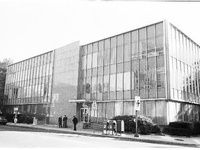Removing Knafel’s name from the center was a calculated move to raise the missing funds.
Naming rights are typically offered up to potential donors like carrots on sticks.
And the University is currently looking for a donation in the “$30 million range” for that building, says development office spokesperson Andy Tiedemann.
Knafel says he could have dug in his heels and insisted on keeping his name over the entire center, but after “forthright” talks with University fundraisers he agreed to the naming change.
“Calling two buildings ‘Knafel Center’ satisfies a crying ego need I apparently have,” Knafel says. “But I figured I could overcome that and free up a building for some guy who’s got to come along and shell out a couple of bucks.”
Multimedia
“There are too many things Harvard has to do,” he adds. “One thing they shouldn’t have to do is battle with their supporters.”
Knafel remains CGIS’ lead backer and deserves an “enormous amount of credit” for getting the project off the ground, Tiedemann says.
The University is also looking for more donations and, in the process, will be naming other rooms in the center.
CGIS has 35 “naming opporunities,” as development officials refer to naming rights, including rooms, centers and even a garden. So far, Tiedemann says, the University has filled five of the slots—for a total of $9.5 million. But fundraisers hope to raise the full cost of CGIS by the time the University hopes it will be dedicated in late 2004 or early 2005.
Fundraisers are looking for a $3 million donation for the naming of the Harvard-MIT Data Center, which distributes social science data sets to researchers; a $1 million donation for a 125-seat amphitheater; and $1 million for the center’s library reading area. Other seminar and meeting rooms will be named for $100,000 to $1 million gifts, depending on their size and prominence.
As for the project’s original donor, Tiedemann says the prominence of Knafel’s name has stayed roughly the same.
“Sid was financing one new building” under the initial plan, Tiedemann says. “Now he is funding one new building.”
“Sid” Knafel is a venture capital investor, whose investments range from cable television to cellular telephones, biotechnology, and computer software.
International research is not an intellectual passion of his, Knafel says. But for a time he chaired the Overseer’s Visiting Committee to the Center for International Affairs, a position that put him in contact with the Faculty who use Coolidge Hall and who will use CGIS.
As the University kicked off its $2.1 billion capital campaign, Knafel says he looked for ways of jump-starting a major project.
“I knew that this effort for the government department and the international research centers hadn’t started,” he says. “There was no one, no motion.”
Later, as the project’s cost rose, Knafel shifted another $5 million donation to Harvard over to the Knafel Center fund. He increased his donation a second time in the hopes of giving momentum to the fundraising effort for the center and inspiring other seven- and eight-figure gifts.
Designing the center has taken longer than Knafel thought it would. But he says the University is better off for the changes that Cobb recommended and Cambridge residents insisted on.
“I have patience here,” he says. “This building’s going to be there for a couple of hundred years, so you can sacrifice a couple of years.”
—Staff writer Andrew S. Holbrook can be reached at holbr@fas.harvard.edu.









